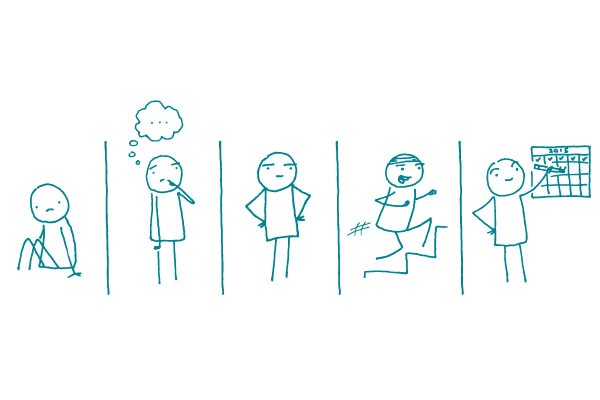
Most of us can name a few things we could do to live healthier lives: eat more fruits and vegetables, exercise for 30 minutes a day, get at least 8 hours of sleep every night.
So, because we know these behaviors will improve our well-being, we all do them, right? Um. Well, no.
The truth is that we’re not always ready to change our behaviors. In fact, research shows that at any given time, only about 1 in 5 people are prepared to give up an unhealthy behavior or adopt a healthy one.
According to the Stages of Change theory (also known as the Transtheoretical model), most of us go through 5 stages before and during behavior change:
- Not ready (Precontemplation)
You don’t intend to change your behavior in the next 6 months. You may see more cons than pros to changing, or you may have given up hope that you can make the change at all. You may not even know your current behavior is unhealthy. You may need information or encouragement. - Getting ready (Contemplation)
You intend to change your behavior in the next 6 months, but you’re still reluctant. You probably think the pros and cons of changing are about equal, so you may need someone you trust to remind you of the pros. - Ready (Preparation)
You plan to take action in the next 30 days. You believe the pros of changing outweigh the cons. You may begin taking small steps toward making the change, like telling your friends and family. - Action
You have changed your behavior in the last 6 months. You may need to use techniques to keep you moving forward, like giving yourself rewards for making healthy changes. - Continuing (Maintenance)
You changed your behavior more than 6 months ago. You need consistent support to avoid slipping back into the unhealthy behavior.
As health communicators, we can be more effective if we tailor messages to our audience’s stage of change.
Say you want to convince your friend to stop smoking. You may instinctively say, “Smoking’s bad for you! Stop smoking right away!”
But what if your friend hasn’t even begun to think about quitting? He’s probably not ready to throw his cigarettes in the trash and call it a day. He may need more information about the benefits of quitting or encouragement that quitting is possible.
So instead, you could say, “I want you to quit smoking because you’ll feel healthier and live longer. I know you may not be ready to quit now, but I believe you can do it eventually.”
It’s also important to remember that these 5 stages can fluctuate — for example, at the start of the year many people are at the gym trying to lose weight, but by Valentine’s Day they’re back on the couch contemplating.
The bottom line: When writing health information, consider where your readers are in the Stages of Change model. Then write action steps to match that stage.
Browse recent posts